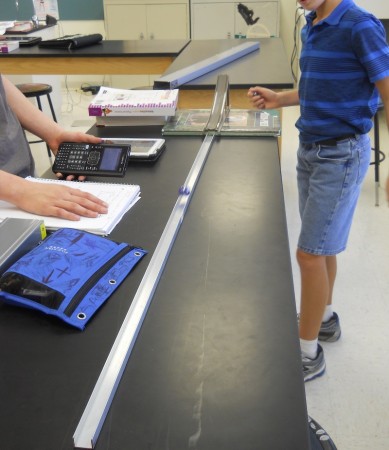I had one of my middle school student groups try a conservation of momentum experiment that, while they made it out very well in the end, did not do a good job of conserving momentum.

The students rolled a marble down a ramp by itself and measured its velocity across a horizontal track. The velocity measurement let them calculate the marble’s momentum across the track since they’d measured the mass of the marble before rolling it down the ramp:
momentum = mass x velocity
Note that since mass was measured in grams (g) and velocity in centimeters per second (cm/s), their units of momentum were gram-centimeters per second (g cm/s).
That was the easy part.
Next they put a second marble at the bottom of the ramp as a target, so the first marble would hit it and redistribute the momentum.
Because it was a collision between two marbles, there was no easy way to make the collision sticky, so they ended up with two marbles moving off at different speeds. Measuring the speeds of the two marbles at the same time was tricky, but they got it done.
Finally, they could calculate the momentum of the two marbles at the end, and the combined momentum should have been equal to the momentum of the one marble from before if momentum had been conserved.
When they did the math, the marbles after collision had about 80% of the momentum of the single marble. This difference allowed them to explain, in their presentation, that momentum was not completely conserved — and in real life it almost never is — because some energy was lost in the collision. Fortunately, we’d already had the presentation on friction so the context of energy losses, and resistive forces could be incorporated into the discussion.
I suspect that some significant portion of the difference in momentum measured was due to the fact that they were using stopwatches to measure the time the marbles took to move between two markers on the track. I’d love to have a motion detector or photogates for this experiment.
